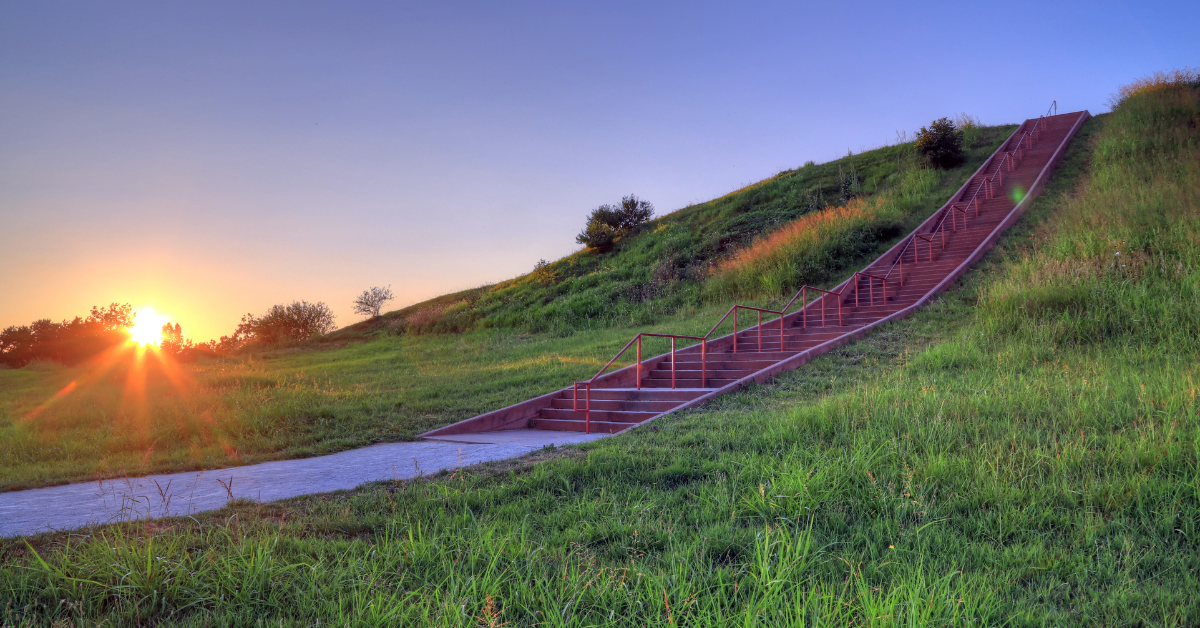Cahokia Mounds State Historic Site, located in Illinois, is North America’s largest pre-Columbian archaeological site. For many Japanese visitors, discovering such a place in the United States brings unexpected surprise and deep emotional impact. This article explores the meaning of Cahokia through the lens of Japanese travelers, offering foreign readers a new angle on this mysterious and powerful cultural heritage.
What is the Cahokia Mounds State Historic Site?
Cahokia Mounds, situated near St. Louis in Illinois, is an ancient city that thrived from approximately 800 to 1400 CE. At its peak, it was home to an estimated 20,000 residents, a population rivaling cities like London or Kyoto at the same period.
The most iconic structure is the Monks Mound, a massive earthen construction towering over 30 meters. Its sheer size and engineering demonstrate the advanced civil organization and technical expertise of the era.
Here’s a breakdown of the main mounds and their functions:
| Mound Name | Characteristics and Purpose |
|---|---|
| Monks Mound | Ceremonial platform, likely a ruler’s residence |
| Sun Circle | Astronomical observatory used for calendar tracking |
| Funnel Mound | Burial mound |
| Other Small Mounds | Possibly residential or religious structures |
Visitor Experience: Attractions and Challenges
For Japanese tourists, visiting Cahokia is a mixture of awe and peaceful immersion. The on-site Visitor Center provides detailed exhibits on indigenous life, ceremonies, and society, supplemented with videos and visual aids. Though there is minimal Japanese-language content, the visually driven presentations are highly engaging.
That said, transportation access is a clear obstacle. Public transit is virtually nonexistent, and most travelers must rent a car. Nearby accommodations and restaurants are limited, so advanced planning is essential.
| Item | Details |
|---|---|
| Recommended Visit Time | 2–3 hours |
| Transportation | Car (rental highly recommended) |
| Nearby Facilities | Convenience stores and cafes within a few-minute drive |
| Toilets/Rest Areas | Clean and available at the Visitor Center |
Here are practical precautions for visitors:
| Consideration | Recommended Action |
|---|---|
| English-only signs | Use a translation app |
| Hot weather | Bring a hat and water bottle |
| Vast grounds | Wear comfortable walking shoes |
| Weather impact | Check local forecast in advance |
Japanese Appreciation of Silence and Earthly Energy
What deeply resonates with Japanese visitors is the profound silence and natural energy of the site. With no mechanical noises, only the sounds of wind, rustling grass, and birds fill the air. It becomes a deeply moving experience—freeing one from the noise of modern life.
Early mornings and late afternoons offer especially mesmerizing views from the top of Monks Mound, where one can envision the ancient civilization that once flourished. This sensation echoes the spiritual atmosphere found in Japanese temples and shrines.
Here’s how Japanese tourists commonly describe the experience:
| Appeal Element | Impressions From Visitors |
|---|---|
| Silence | Calm and deeply meditative atmosphere |
| Scenery | A sense of being enveloped by earth and sky |
| Historical Presence | Feeling connected to the past simply by standing there |
| Spiritual Energy | Many report a mysterious and sacred vibe |
Differences in Historical Education: A Cultural Realization
In Japanese education, America is often portrayed as a modern nation born from independence, with minimal mention of indigenous civilizations. Therefore, seeing a large-scale pre-Columbian urban site is an eye-opener.
Cahokia features organized residential zones, religious centers, burial sites, and even astronomical structures—clearly indicating an intentional, planned urban society. These insights challenge the limited definitions of “civilization” typically taught in Japan.
Furthermore, the evidence of organized agriculture, trade, rituals, and governance reshapes many visitors’ understanding of what constitutes an “advanced” society.
Japanese Reviews and Overall Impressions
Reviews from Japanese visitors overwhelmingly express astonishment and appreciation. Many say they want to return, citing a memorable emotional and cultural experience.
Yet, some express concerns regarding transportation difficulties, language barriers, or lack of context. These issues, however, can be largely mitigated with research and preparation.
| Evaluation Category | Visitor Feedback |
|---|---|
| Positive Reactions | Impressive scale, soothing nature, profound silence |
| Challenges | Accessibility, lack of Japanese materials, complex exhibits |
| Willingness to Revisit | High (many want to visit again) |
| Overall Satisfaction | Very high (many call it a deeply moving experience) |
Conclusion
Cahokia Mounds is a silent miracle of ancient North America. More than just a historical site, it is a place where visitors can feel the power of culture, the beauty of nature, and the ingenuity of humanity.
For Japanese travelers, it offers new historical insights and an opportunity to contrast their own cultural perspectives with those of early American civilizations. With a bit of planning, the transportation and language limitations are easily overcome.
If you’re looking for your next travel destination, consider experiencing the timeless peace and spiritual richness of Cahokia firsthand.






